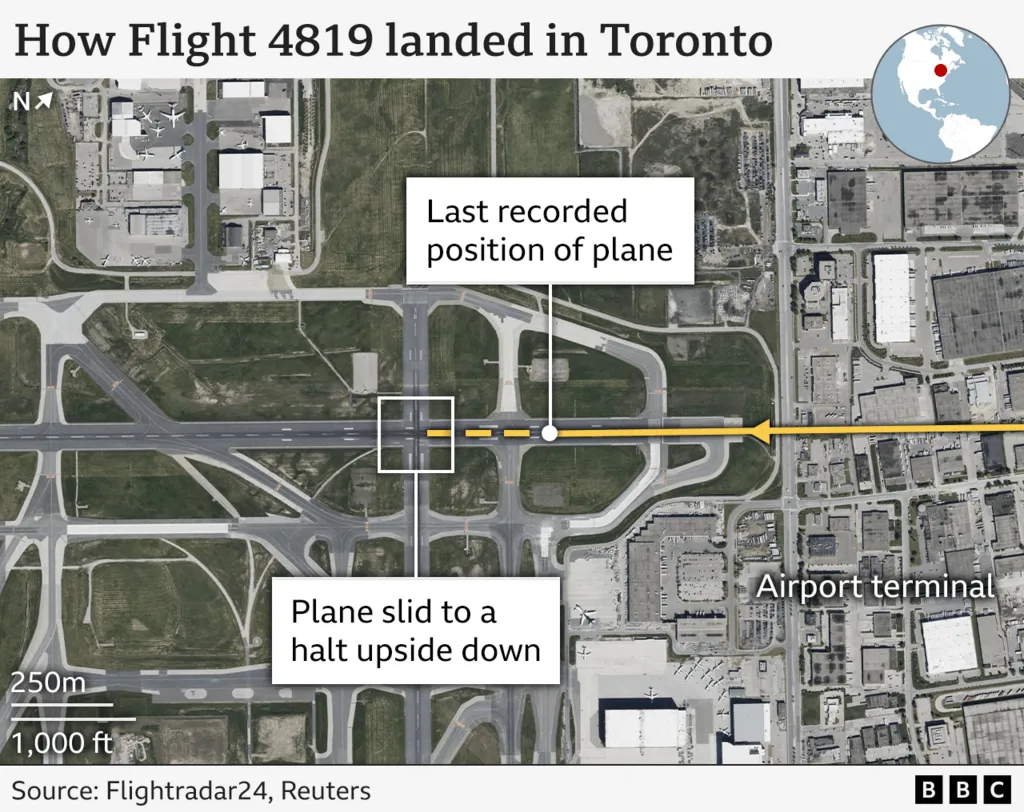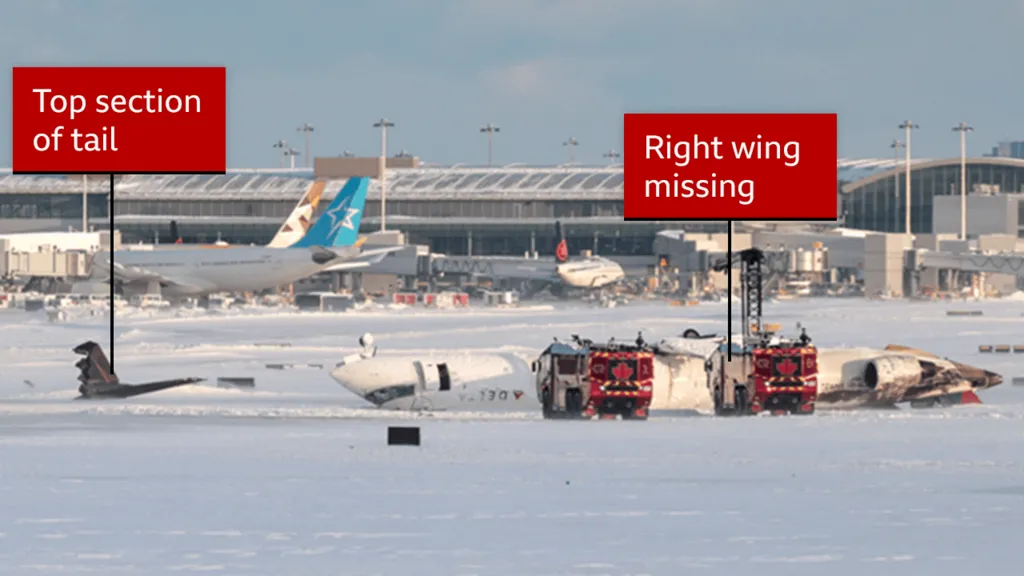On a seemingly routine flight from Minneapolis to Toronto, a Delta Air Lines CRJ-900 aircraft experienced a catastrophic crash landing. Despite the severity of the accident, all 80 passengers and crew survived, an outcome that has been hailed as nothing short of miraculous. This article explores the events leading up to the crash, the possible causes, and the key factors that contributed to the survival of everyone on board.
Details of the Incident
The crash occurred on Monday at approximately 14:00 local time (19:00 GMT) as Delta flight DL4819 was attempting to land at Toronto Pearson International Airport. The aircraft struck the runway, skidded, and eventually flipped over, resulting in the loss of its tail and an entire wing. The plane burst into flames upon impact, prompting a swift response from emergency services.
Passengers described a harrowing scene, with many hanging upside down in their seats before scrambling over luggage to exit the overturned aircraft onto the snowy runway. Despite the dramatic nature of the crash, no fatalities were reported. Initial reports indicated that 21 passengers were hospitalized, but 19 were later discharged with minor injuries.

Possible Causes of the Crash
While the exact cause remains under investigation, aviation analysts have suggested several possibilities:
- Hard Landing: Experts believe the aircraft may have made an abnormally hard landing, which could have caused structural failure.
- Adverse Weather Conditions: Although the runway was reported to be dry, high winds and frigid temperatures may have contributed to the crash.
- Landing Gear Collapse: Analysts noted that the aircraft may have landed with one wheel first, potentially leading to the collapse of the landing gear, which in turn could have triggered the rollover.
- Pilot Maneuvering: The pilots reportedly attempted a “crab maneuver” to counteract strong winds, but this may have contributed to the instability upon landing.
Survival Factors
The survival of all 80 people on board can be attributed to a combination of factors:
- The Plane’s Structural Integrity: The fuselage remained largely intact despite the severe impact.
- Modern Safety Features: The aircraft was designed to absorb impact and break apart in a way that minimized harm to passengers.
- Efficient Emergency Response: Firefighters arrived within minutes to extinguish the flames and assist with evacuations.
- Passenger Cooperation: Eyewitnesses noted that passengers worked together to escape, displaying remarkable composure and teamwork.

Role of Plane Design and Safety Features
Modern aircraft are built with stringent safety measures, many of which played a crucial role in this incident:
- High-Impact Seats: The CRJ-900 is equipped with 16g seats, designed to withstand deceleration forces 16 times greater than gravity. These seats absorb impact energy, reducing the likelihood of spinal injuries.
- Seatbelt Effectiveness: Advances in seatbelt design ensure passengers remain securely fastened in place, preventing serious injuries during turbulence or crashes.
- Wing and Fuselage Separation: The plane’s wings detached as intended upon impact, preventing additional structural damage to the fuselage.
- Cabin Layout and Design: Everything from seat-back trays to overhead compartments is designed to minimize injury risks in case of accidents.
Passenger and Crew Response
The actions of both passengers and crew members significantly contributed to the safe evacuation of the aircraft. Flight attendants followed emergency protocols to ensure a quick and orderly exit. Passengers also displayed remarkable presence of mind, assisting one another in navigating the overturned cabin.
One survivor, Pete Carlson, described how the collective effort among passengers created a sense of unity in the chaotic moments following the crash. He credited the seatbelts, cabin layout, and quick emergency response as key factors in ensuring that all passengers escaped with minimal injuries.
Comparison to Recent Aviation Accidents
The Toronto crash is one of several recent aviation incidents in North America. While tragic, these accidents reinforce the notion that air travel remains one of the safest modes of transportation due to continuous advancements in aircraft safety features and emergency response strategies.
Some notable incidents include:
- January 29: A mid-air collision near Washington, D.C., resulted in 67 fatalities.
- February 1: A medical transport plane crashed in Philadelphia, killing seven.
- February 6: A small plane crash in Alaska claimed ten lives.
- December (South Korea): A devastating crash led to 179 fatalities.
Despite these accidents, aviation safety continues to improve, and experts emphasize that incidents like the Toronto crash highlight the effectiveness of modern aircraft safety mechanisms.
Conclusion
The Delta flight DL4819 crash landing in Toronto stands as a testament to the remarkable advancements in aviation safety. While the incident was harrowing, the fact that all 80 people on board survived underscores the importance of rigorous safety standards, well-trained crew members, and quick emergency responses. As investigations continue, the aviation industry will undoubtedly use this case to further refine safety measures, ensuring that future incidents are even more survivable.
The resilience displayed by passengers and crew alike serves as a reminder of the human spirit’s ability to endure even the most terrifying circumstances, reinforcing the notion that flying remains an incredibly safe and reliable means of travel.
